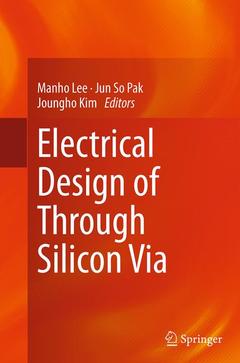Description
Electrical Design of Through Silicon Via, Softcover reprint of the original 1st ed. 2014
Language: English
Subject for Electrical Design of Through Silicon Via:
Publication date: 09-2016
Support: Print on demand
Publication date: 05-2014
280 p. · 15.5x23.5 cm · Hardback
Description
/li>Contents
/li>Biography
/li>Comment
/li>
Through Silicon Via (TSV) is a key technology for realizing three-dimensional integrated circuits (3D ICs) for future high-performance and low-power systems with small form factors. This book covers both qualitative and quantitative approaches to give insights of modeling TSV in a various viewpoints such as signal integrity, power integrity and thermal integrity. Most of the analysis in this book includes simulations, numerical modelings and measurements for verification. The author and co-authors in each chapter have studied deep into TSV for many years and the accumulated technical know-hows and tips for related subjects are comprehensively covered.
Preface.
Chapter 1 Introduction. 1.1 TSV-based 3D ICs. 1.2 Core Technologies and Electrical Reliability Design for TSV-based 3D IC. 1.3 Electrical Analysis of TSVs based on MIS Analysis. References.
Chapter 2 Electrical Modeling of a Through-Silicon Via (TSV). 2.1 Introduction. 2.2 Equivalent Circuit Model of a TSV. 2.3 Electrical Characterization and Analysis of a TSV Channel. 2.4 Electrical Analysis of a Single-ended and Differential Signal TSV Channel. 2.5 Summary. References.
Chapter 3 High-speed TSV-based Channel Modeling and Design. 3.1 Introduction. 3.2 Model of High-speed TSV-based Channel. 3.3 Analysis of High-speed TSV-based Channel. 3.4 Worst-case Eye-diagram Estimation Algorithm. 3.5 Summary. References.
Chapter 4 Noise Coupling and Shielding in 3D ICs. 4.1 Overview. 4.2 Analysis of Noise Coupling in 3D ICs. 4.3 Analysis of Shielding Structures in 3D-IC. 4.4 Summary. References.
Chapter 5 Thermal Effects on TSV Signal Integrity. 5.1 Overview. 5.2 Temperature-dependent TSV Isolation Characteristics and Model. 5.3 Temperature-dependent TSV Channel. 5.4 Summary. References.
Chapter 6 Power Distribution Network (PDN) Modeling and Analysis for TSV and Interposer-based 3D-ICs in the Frequency Domain. 6.1 Introduction. 6.2 Modeling of PDNs in TSV-based 3D-ICs. 6.3 Analysis of the PDN Impedance in TSV-based 3D-ICs in the Frequency Domain. 6.4Summary. References.
Chapter 7 TSV Decoupling Schemes. 7.1 Introduction. 7.2 Decoupling Capacitor Schemes. 7.3 Application and Design of TSV-based Decoupling Schemes. 7.4 Summary. References.
Index.
Manho Lee received the B.S. and M.S. degrees in electrical engineering from the Korea Advanced Institute of Science and Technology, Daejeon, Korea, in 2010 and 2012, respectively, where he is currently pursuing the Ph.D. degree in electrical engineering.
His current research interests include the modeling of noise coupling between active circuit and TSV.
Jun So Pak (M'02) received the B.S. degree in electrical communication engineering from Hanyang University, Seoul, Korea, in 1998 and the M.S. and Ph.D. degrees in electrical engineering from the Korea Advanced Institute of Science and Technology (KAIST), Daejeon, Korea, in 2000 and 2005, respectively.
He was a Research Fellow with the High Density Interconnection Group, National Institute of Advanced Industrial Science and Technology, Tsukuba, Japan, in 2005, where he was involved in development of interconnection techniques and interposers for 3-D multichip packaging. Since 2007, he has been a Research Professor with the Department of Electrical Engineering, KAIST. He was the Founder and Director of the 3D-IC Research Center (3DIC- RC) in 2005. His current research interests include development of 3-D stacked chip packaging using through silicon via.
Dr. Pak was a recipient of the Research Fellowship Award from the Japan Society for the Promotion of Science in 2005.
Joungho Kim (M'04) received the B.S. and M.S. degrees from Seoul National University, Seoul, Korea, in 1984 and 1986, respectively and the Ph.D. degree from the University of Michigan, Ann Arbor, in 1993, all in electrical engineering. He was involved in femtosecond time-domain optical measurement techniques for high-speed devices and circuit testing during his graduate study.After completing the Ph.D. degree, he joined Picometrix, Inc., Ann Arbor, MI, in 1993, as a Research Engineer, where he was involved in development of pico-second sampling systems and 70-GHz photoreceivers. He joined the Memor
Provides fundamental modeling of TSV which is a very essential part of 3D ICs
Includes both numerical formula analysis and qualitative explanations
Approach from various view points: signal integrity, power integrity and etc.
Has appeal for academia and industry
Includes supplementary material: sn.pub/extras

